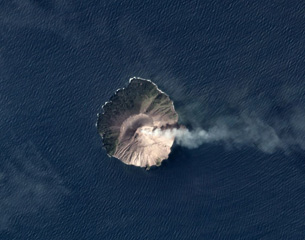Report on Kadovar (Papua New Guinea) — 15 July-21 July 2020
Smithsonian Institution / US Geological Survey
Weekly Volcanic Activity Report, 15 July-21 July 2020
Managing Editor: Sally Sennert.
Please cite this report as:
Global Volcanism Program, 2020. Report on Kadovar (Papua New Guinea) (Sennert, S, ed.). Weekly Volcanic Activity Report, 15 July-21 July 2020. Smithsonian Institution and US Geological Survey.
Kadovar
Papua New Guinea
3.608°S, 144.588°E; summit elev. 365 m
All times are local (unless otherwise noted)
RVO reported minor eruptive activity at Kadovar during 1-15 July consisting of occasional light gray ash plumes of variable densities rising a few hundred meters above the summit crater. Fluctuating summit incandescence was visible at night. Activity intensified on 5 July as emissions became dark gray and dense. Explosions at 1652 and 1815 generated dense dark gray ash plumes that rose 1 km and drifted W. Loud rumbling accompanied the explosion. Activity subsided later that day but was again more intense during 8-10 July. Explosions recorded at 2045 on 8 July, 1145 and 1400 on 9 July, and at 0950 and 1125 on 10 July produced ash plumes that rose 1 km above the summit.
Geological Summary. The 2-km-wide island of Kadovar is the emergent summit of a Bismarck Sea stratovolcano of Holocene age. It is part of the Schouten Islands, and lies off the coast of New Guinea, about 25 km N of the mouth of the Sepik River. Prior to an eruption that began in 2018, a lava dome formed the high point of the andesitic volcano, filling an arcuate landslide scarp open to the south; submarine debris-avalanche deposits occur in that direction. Thick lava flows with columnar jointing forms low cliffs along the coast. The youthful island lacks fringing or offshore reefs. A period of heightened thermal phenomena took place in 1976. An eruption began in January 2018 that included lava effusion from vents at the summit and at the E coast.
Source: Rabaul Volcano Observatory (RVO)

